|
|
|
| My Favourite Planet > English > Europe > Greece > Macedonia > Kavala |
| Kavala, Greece |
Activities and sightseeing in Kavala |
 |
page 5 |
 |
|
| |

A pair of sightseers in Kavala. |
| |
|
| |
Kavala is a very pleasant city to walk around and explore, and although the atmosphere is of a modern bustling port, it has several historic sights and monuments worth viewing.
If your time is limited, a walk from the main harbour to the Kamares aqueduct, then up through the narrow lanes of the old district of Panagia to the Castle (Kastro), passing the Imaret, Mosque, and the House of Mehmet Ali can be done in 2 hours.
The Kavala Tourist Information Centre (see page 3: practical information for further details), in the centre of the city provides maps and information about local attractions.
Kavala's official website offers information about sights, sites and museums in the city and the surrounding region, including a downloadable PDF list, although some details such as opening times are now out of date:
kavalagreece.gr/en/catalogues/museums_and_archaeological.pdf
Church opening times
As in the rest of Greece, churches are usually open in the mornings, evenings and during services. Most churches close at midday. |
|
| |
| |
Kavala
sights |
Kavala city centre |
|
 |
|
|
| |
|
| |
Until the mid 19th century the city of Kavala was restricted to the walled area of the peninsula now known as the Panagia district (see below). In 1864 Ottoman Sultan Abdülaziz I gave permission for Kavalans to build outside the city walls, which led to a building boom to the end of the century.
Warehouses, factories and the grand houses of tobacco traders sprung up around the main harbour which became the new city centre. Following Macedonia's independence from Turkey, new houses, business premises and churches were built, often at the expense of older buildings, a trend which continued into the late 20th century.
In the late 1920s, for example, the area around Eleftherias Square (Πλατεία Ελευθερίας, Platia Eleftherias, Freedom Square) was cleared to build shops and houses, and several old buildings, including the caravanserai (han) and smaller inns, were demolished.
Today modern concrete blocks dominate the cityscape of the centre and suburbs, but there are still several examples of more interesting architecture to be found around Kavala's streets.
In the very centre of the city, behind Eleftheriou Venizelou Street, one of the main streets, Odos Kyprou is lined with a row of grand buildings in eclectic styles, built by the great and the good of Kavala during the local tobacco boom of the late 19th and early 20th centuries. In the middle of this row is the Town Hall, the former Herzog Mansion. |
|


 |
|
| |
Tokou Mansion
Μέγαρο Τόκου, Megara Tokou
Odos Kiprou 14, Kavala 6540.
To the left (west) of the Town Hall (see below).
The Tokou Mansion was built in 1879 by the tobacco merchant Dimitrios Tokos (Δημήτριος Τόκος) in an eclectic mix of Ottoman neoclassical and Baroque styles with elements of local architectural traditions.
In 1911 it was used as the Italian Consulate, and was later purchased for the Charitable Sisterhood of the Ladies of Kavala (Φιλοπτώχου Αδελφότητας Κυριών Καβάλας, Φ.Α.Κ.Κ., Philoptochou Adelphotitas Kyrion Kavalas).
Following the liberation of the city in 1913, the house was used as the town hall until 1937 when the municipal administration moved into the present building (see below). Greek Prime Minister Eleftherios Venizelos made a speech from the house's balcony during his visit to Kavala in 1929.
After the Second World War the house became the private Papasideri high school. In 1979 it was purchased by the Ministry of Culture and restored to provide the offices of the 12th Ephorate of Byzantine Antiquities, which manages the monuments and museums of Eastern Macedonia and Thrace. |
|
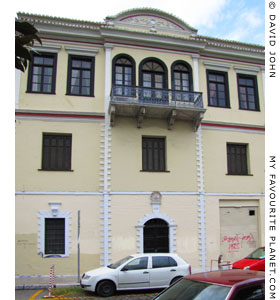
Megara Tokou |
|
| |
The Great Hall
η Μεγάλη Λέσχη, Megali Lesxi; also known as the Grand Hall and the "Great Greek Community Club"
Odos Kiprou 12, Kavala 6540.
To the left (west) of the Town Hall (see below).
The neoclassical Great Hall features several elements of classical architecture, including superimposed orders, with Doric and Ionic pilasters, and pediments. The design also mixes triangular pediments and the type of rectangular windows used in ancient Greek buildings, and Roman arched pediments and windows (with balconies and wrought iron railings). The ground floor has a facade of cream-yellow stone cladding in the style of ancient regular stonework, while the walls of the second storey and attic are covered by pink painted stucco. The wall colours show off the white of the pilasters, pediments and windows rather well. The building is topped by a balustrade which runs along the front end of the roof, and is decorated with stone vases.
The design of the exterior as a whole is handsome and well balanced, although the recent addition of large steel and glass shopfronts somewhat spoils the effect.
It was built with funds donated by the Charitable Sisterhood of the Ladies of Kavala (Φιλοπτώχου Αδελφότητας Κυριών Καβάλας, Φ.Α.Κ.Κ., Philoptochou Adelphotitas Kyrion Kavalas) and inaugurated on 22 May 1910. The ground floor was used by the Bank of Athens.
It was purchased and renovated by the Ionian Bank in 1919, and the upper floor was used for social events. From 1944 to 1956 it was used as an officers' club, and then for social events once again. 1983-2003 the Municipal Library was housed here, and today it is used for cultural activities and exhibitions.
During our most recent visit to Kavala (July 2015) the building appeared empty and abandoned. This may be partly due to the Greek economic crisis which has meant fewer cultural events are currently taking place in the city, and partly because events are now being held in the Municipal Tobacco Warehouse (see below). According to local news, the building is being renovated and structurally strengthened, and is due to be reopened in October 2015. |
|
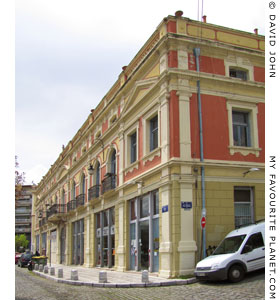
The Great Hall (Megali Lesxi) |
|
| |
Kavala Town Hall
Δημαρχείον, Dimarcheion
Odos Kiprou 10, Kavala 65302.
Tel: 2510 22 78 20
Office hours: 08:00 - 16:00
Built at the end of the 1890s as the residence of the Hungarian tobacco trader Baron Peter Herzog (often referred to as Pierre Herzog) from Budapest, it is one of Kavala's "tobacco baron" mansions.
Herzog was an enormously wealthy Jewish banker, grain and tobacco merchant, an energetic businessman and passionate art collector. He founded the tobacco trading company Herzog et Cie, managed in Kavala by Adolf Wix (see below), and gained a virtual monopoly in Macedonian tobacco. By 1905 he had become the main supplier of the Ottoman Sultan in Istanbul.
He was one of the entrepreneurs who liberalized trade in the declining Ottoman Empire. Until the mid 19th century the Sultan's government and officials had strictly controlled trade and prices in commodities such as tobacco, which merchants, especially foreign investors, considered a hindrance to trade and profit-making.
Through the skilful negotiation of advantageous trading concessions with the Turkish authorities, western capitalists were able to introduce new production, processing, trading and shipping methods, and make larger profits quicker by supplying demands in domestic and foreign markets.
Tobacco was turned into a highly profitable cash crop as demand for the weed rapidly increased in Turkey and internationally, and smoking tobacco, particularly Balkan and Turkish blends, became fashionable among all classes. Similar economic and commercial changes, due largely to the influence of such foreign investors, were taking place in other Turkish cities such as Smyrna (Izmir).
For centuries the city of Kavala had been confined within the walls of the cramped citadel (the Panagia peninsula). However, after Sultan Abdulaziz I gave permission for building outside the walls in 1864, warehouses, factories and the grand representative houses of the wealthy, built in neoclassical and other eclectic styles, sprang up around the harbour. With such mansions and other buildings, the "tobacco barons" boldly demonstrated their wealth, power and influence. At the time this very foreign, literally outlandish architecture must have appeared quite alien to Turks and Greeks alike.
With its crenalleted battlements, miniature towers and other decorative elements the mansion resembles a central European Gothic castle. This impression is added to by the fact that it stands on Kiprou Street which is elevated above the level of the main Eleftheriou Venizelou Street.
After Herzog's death, his son Baron Mór Lipót Herzog sold the mansion to another tobacco company in 1921. Eventually the company was forced to sell the house due to debts, and it was purchased in 1937 for the city by the mayor, Athanasiou Balanou. It has since served as Kavala's town hall.
Recently Herzog's descendants have been involved in legal battles to regain artworks from the family collection he started which were looted during the Second World War.
Website: www.kavala.gov.gr |
|
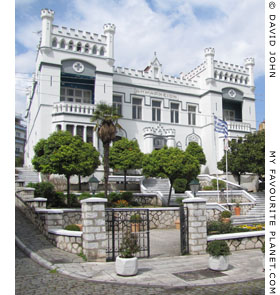
Kavala Town Hall
See more photos of the Town Hall
on gallery page 29.
See also:
Tobacco Museum of Kavala (below) |
|
| |
Heroon Park
The Heroes' Public Park (Πάρκο Ηρώων, Parko Iroon) or Heroes' Municipal Gardens (Δημοτικος Κηπος Ηρωων, Dimotikos Kipos Iroon).
On Eleftheriou Venizelou Street, directly in front of the Town Hall, the park's trees and benches, as well as an open-air cafe, provide welcome shade and rest. It can get full in the summer, and is a favourite hangout for young people in the evenings.
For travellers, a good place to relax while waiting for a bus or ferry.
The park contains several busts of local Greek heroes, a marble monument to Alexander the Great (of course), a bronze statue of Nike (the Greek goddess of Victory) made by Cretan sculptor Yannis Parmakelis (Γιάννης Παρμακέλης) in 1970, and a large marble relief by Dionysios Gerolymatos (Διονύσιος Γερολυμάτος) depicting the struggles of the Macedonian people. All very patriotic. |
|
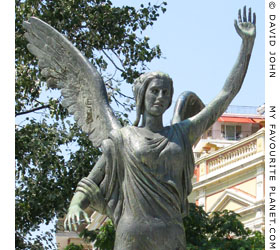
Statue of Nike
by Yannis Parmakelis, 1970. |
|
| |
Wix Mansion
Μέγαρο Wix, Megaro Wix
Odos Kiprou 8, Kavala 65403.
Just to the right (east) of the Town Hall is another "tobacco baron" mansion. This one was built in 1899 (although some sources say 1906) by the Hungarian Baron Adolf Wix von Zsolnay.
Adolf Wix (1866-1932) came from a Jewish family in the Carpathians. As a young man he worked for Peter Herzog (see above) in Budapest. He was sent by Herzog to manage his company's tobacco trading interests in Kavala, where he was very successful and earned a fortune.
He was also appointed Austro-Hungarian Consul General, and in 1904 he was made a Hungarian baron. He married Herzog's daughter, and eventually retired to Vienna, where he built an even grander castle-like mansion.
In 1925 the mansion was sold to an American tobacco company and thereafter had several other owners before being acquired by the Municipality of Kavala.
Now known as "the small town hall", it contains the offices of municipal departments such as the Technical Services, Planning, Development and Digital Services.
Like his employer Baron Peter Herzog (see above), Adolf Wix was also a collector of art and antiquities. Many ancient artifacts from the Wix Collection, found at local sites such as Philippi, Thasos and Amphipolis, are now in Vienna, while some can be seen in the Kavala Archaeological Museum (see below). [1] |
|
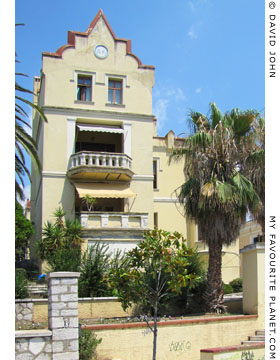
The Wix Mansion |
| |
Lazarist Monastery
Η Μονή Λαζαριστών, Monastere Lazariste Francais
Odos Kiprou 6, Kavala.
Tel: 2510 22 31 63 and 2310 53 95 59
Just east of the Wix Mansion, the Lazarist Monastery, built between 1888 and 1892, is another grand foreign edifice in an eclectic architectural style, with neoclassical influence.
The Congregation of the Mission (Congregatio Missionis), also known as the Vincentians, Lazarists, Lazarites and Lazarians, is a Roman Catholic religious order of priests and monks, founded in 1624 in the Collège des Bons Enfants, Paris, France. Their patron and founder was Saint Vincent de Paul (1581-1660), a priest renowned for his work with the poor. They established several missions around the world, particularly during the 19th century.
The monastery was used as the French Consulate during the First World War, and as a school for the teaching of French. It is currently the Roman Catholic church for the parish of Kavala, founded in 1900.
Saint Joseph's Church in Alexandroupoli, Thrace
also belongs to the Lazarist order. |
|
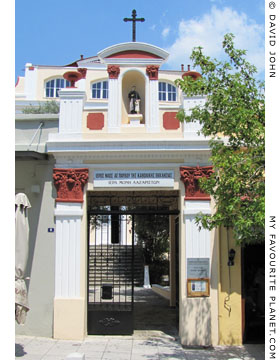
The Lazarist Monastery |
|
| |
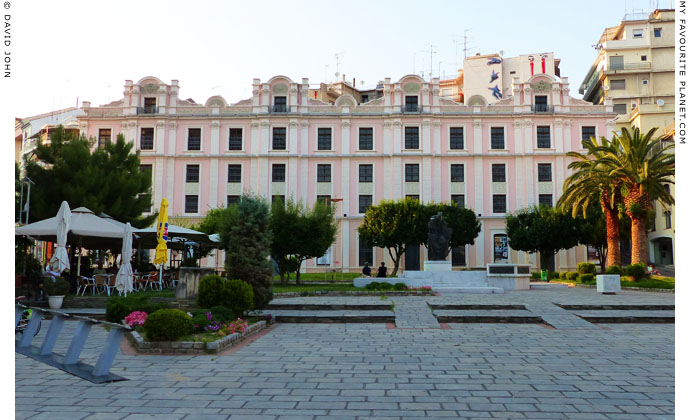
The Municipal Tobacco Warehouse in the centre of Kavala. |
| |
Municipal Tobacco Warehouse
Δημοτική Καπναποθήκη
Kapnergati Square, Kavala 65302.
Tel: +30 2510 222706
The Warehouse was built in the first decade of the 20th century for the Turkish tobacco merchant Kizi Mimin. Another of Kavala's grand buildings in Ottoman neoclassical style with Baroque elements, today its pink walls, decorative pilasters, friezes - not to mention its many large, barred windows - make it look more like a Spanish colonial palace than a late Ottoman industrial warehouse.
The building was acquired by the Municipality of Kavala, and following renovation is now used as a venue for cultural events.
It is also the home of the Maritime Museum of Kavala (see below).
The large triangular-shaped Plateia Kapnergati (also known as Plateia 28th Oktovriou) is at the east end of Odos Kiprou on which the Town Hall stands.
See also the Tobacco Museum of Kavala below. |
|
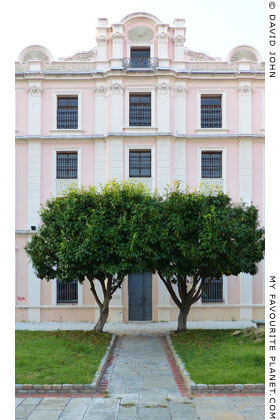
The facade of the Tobacco warehouse. |
|
|
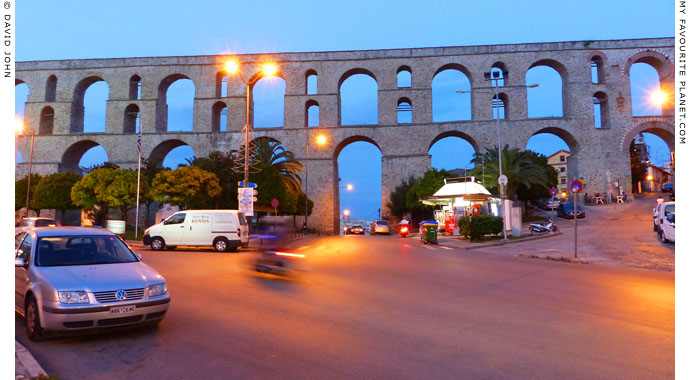
The Kamares aqueduct in the early evening. |
| |
Kamares aqueduct
Οι Καμάρες, Kamares, the Arches
Odos Pal. Idragogiou, Kavala 65201.
Just east of Plateia Nikotsara.
Around 300 metres east of the Church of Saint Nicholas
(see below), along Odos Konutoriotou.
It is thought that an aqueduct was first built here during the late Roman or Byzantine period and destroyed in the 14th century. During the mid 16th century it was either restored or completely rebuilt, probably by Pargali Ibrahim Pasha (Pargalı İbrahim Paşa, 1523-1536), Grand Vizier of Ottoman Sultan Suleyman the Magnificent (1494-1566), who also built the Ibrahim Pasha Mosque in Kavala (see below).
The exact date of the Ottoman construction is unknown, with various theories ranging from the 1520s to the 1550s, although, if Ibrahim Pasha was responsible, around 1530 seems more likely.
The construction of the aqueduct, mosque and other buildings, as well as the refortification of Kavala (then still known as Christoupolis) appear to have been part of concentrated efforts to revive the city following its destruction and depopulation during battles for the control of the area between the Venetians and Turks in the previous century (see page 2: History of Kavala).
The aqueduct was well maintained, with only one major repair required in 1818. It remained in use until the early 20th century. Recent restoration work was undertaken in 1997-1998.
Built of local granite, with Ottoman style brickwork used in some of the arches, the aqueduct is 280 metres long, has a maximum height of 25 metres and a total of 60 arches (some sources say 270 metres long and 26 metres maximum height).
The structure comprises of two tiers of arches supporting the water channel. The bottom tier is thicker and the 11 arches are wider and higher (5.60 metres wide, 12 metres high) than the main arches of the upper tier (5 metres wide, 8 metres high), which are set directly above them. Between the upper tier's main arches each of the stone piers are pierced by two smaller arches, one directly on top of the other, the lower arch being wider and higher than the upper. Metal staves have been used to support some of these smaller arches.
The Kamares spans the lower ground between the foot of Mount Lekani (at the south end of Odos Lahana) and the old city walls on the northeast slope of the hill of the Panagia peninsula.
It was the last stage of a well-planned network of ceramic pipes and four other aqueducts which carried water to the city from the 400 metre high source, known as the "Mother of Water" (η μάνα του νερού, i Mana tou Nero; also known as ή Τρία Καραγάτσια, i tria Kragatsia, the Three Elms; and ή Σούμπαση, i Soumpasi, after the Turkish word for source), 6 km to the north. Water was also chanelled from other smaller sources nearby.
Some of the water was diverted to drinking fountains and troughs in the countryside along the way for travellers, farmers and their animals.
Within the citadel of Kavala, water was distributed by pipes to storage tanks, public fountains (of which the remains of three are still extant), baths and important buildings. The first house in Kavala to have running water was the House of Mehmet Ali, built around 1780-90 (see below). |
|
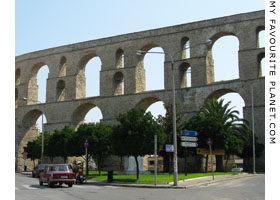
The Kamares aqueduct |
| |

One of the birdhouses on
the west side of the aqueduct. |
| |
See more photos of the Kamares
aqueduct on gallery page 12. |
|
| |
Church of Saint Nicholas
Ναός Αγίου Νικολάου Καβάλας, Agios Nikolaos Orthodox Church
Plateia Agiou Nikolaou Kavala, Kavala 65302.
Tel: +30 2510 22 45 27
The church was originally the Ibrahim Pasha Mosque (το Τζαμί του Ιμπραήμ Πασά; Turkish, İbrahim Paşa Camii), the largest mosque of Kavala, built in 1530 by Pargali Ibrahim Pasha (Pargalı İbrahim Paşa, 1523-1536), Grand Vizier to Sultan Suleyman the Magnificent.
Ibrahim was the son of a Greek sailor in Parga, Epirus, northwestern Greece, which at the time was controlled by Venice. As a boy he was kidnapped by pirates and sold as a slave. He worked at the Ottoman royal palace in Manisa, western Turkey, where he was befriended by the young prince Suleyman. He converted to Islam and rose in Suleyman's service to be his most trusted advisor. However, the two men fell out, and Suleyman had him executed.
Ibrahim Pasha is thought also to be responsible for building or restoration of the Kamares aqueduct (see above).
The mosque was converted to a church around 1926, and a bell tower was built on the base of the minaret. Appropriately for a church near the harbour, it was dedicated in 1945 to Saint Nicholas (Agios Nikolaos), the patron saint of sailors.
Because it was built as a mosque, its plan is oriented so that one wall faces Mecca, rather than the strict east-facing arrangement of Christian churches.
The marble and mosaic Apostle Paul Monument (see below) can be seen in the photo, right, just below the bell tower.
As with most churches in Greece, it is open in the mornings and evenings, and during services, but closed during the afternoon siesta hours. |
|
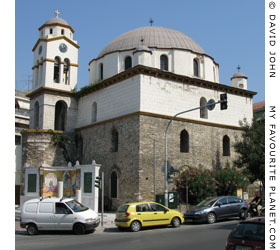
The Church of Saint Nicholas,
formerly the Ibrahim Pasha Mosque. |
| |
Apostle Paul Monument
The marble monument, outside the Church of Saint Nicholas (see above), designed by painter Vlassios Tsotsonis and decorated with a large wall mosaic made by Pino Pastorutti in 2004, commemorates the Apostle Paul's arrival by ship in the city's harbour, around 49 AD, on his way to preach Christianity in Philippi. This was Paul's first landing on the European mainland. (see page 2: History of Kavala).
Odos Hydras 16, Kavala 65302.
The monument is on the corner with Odos Konutoriotou, on the southwest side of Church of Saint Nicholas.
See also the Agios Silas Monastery below.
Directly across the road from the monument, on the east side of Odos Konutoriotou, is one of the most direct streets leading into the Panagia district (see below). |
|

Detail of the mosaic of the Apostle Paul
Monument, showing Saint Paul setting
foot on the European mainland for the
first time at Neapolis (ancient Kavala). |
|
| |
Beyond the city centre...
If you are staying a few days or more in Kavala and considering wandering around its streets, there is plenty to explore. Although most of the buildings beyond the centre are modern, there is a variety of districts with narrow streets, some stepped, with local churches, cafes and shops. As you go up the steep hill from the centre, there many places from which you can enjoy excellent panoramic views across the town and over the Gulf of Kavala to Thasos. |
|
|
| |
Prophet Ilias Church
Εκκλησία Προφήτη Ηλία, Ekklesia Profiti Ilia
The Old Testament prophet Elijah, known in Greek as Ilias (or Elias), is very popular in Greece, and there many churches dedicated to him. The church in Kavala was first built as a simple wooden chapel in 1928. The present church was built in 1932. From 1966 improvements were gradually made to the building, including the addition of aisles and the narthex. The parish is currently considering constructing a new church.
There are several churches worth visiting in and around Kavala, and this one is nothing special architecturally. However it is worth visiting, if only for the view. It is around 1 km northwest of the Town Hall, set on a stone terrace on a rock outcrop high above the city.
Odos Parthenonos 3, Prophet Ilas district, Kavala 65201.
See:
www.im-philippon.gr/IeroiNaoi/ProfitisIlias.html
(in Greek and English)
There are even better views further up the hill along the wooded paths around the Agios Silas Monastery and the Via Egnatia (see below). |
|
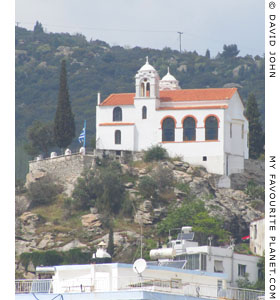
Prophet Ilias Church. |
|
| |
|
|
| |
| |
 |
| |
George Alvanos
rooms in
Kavala's historic Panagia District
Anthemiou 35,
Kavala, Greece
kavalarooms.gr
|
| |
 |
| |
 |
| |
 |
| |
 |
| |
 |
| |
Olive Garden Restaurant
Kastellorizo,
Greece
+30 22460 49 109
kastellorizo.de
|
| |
Papoutsis
Travel Agency
Kastellorizo,
Greece
+30 22460 49 286
greeklodgings.gr
|
| |
| |
Kavala
sights |
Panagia district |
|
 |
|
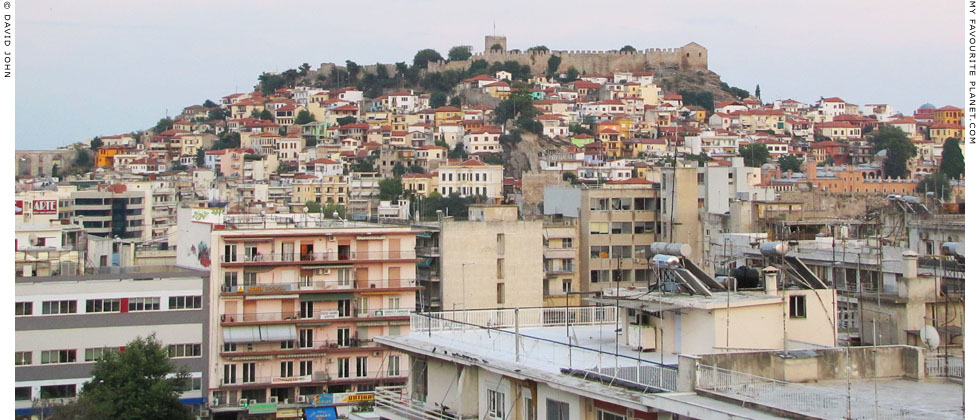
The Byzantine Castle (Kastro) and old houses of the Panagia dsitrict, viewed from the modern city centre. |
| |
| |
|
| |
|
|
The Panagia district (Παναγία) is Kavala's old town, and the location of the ancient city Neapolis.
Nothing remains of ancient Greek or Roman periods, but there are plenty of reminders of Byzantine and Ottoman times, as well as houses and other buildings from the early years of the modern Greek state. Since 2001 many of the old buildings, such as the Imaret and the Halil Bey Mosque have been renovated.
The district also has a couple of good, small tavernas (on Odos Theodorou Poulidou, opposite the Imaret), a few bars and small shops. |
|
|
| |
The Imaret
Το Ιμαρέτ Καβάλας
On the right of Odos Theodorou Poulidou, the street along the west side of the Panagia headland, on the way to the Panagia Church (Kimissi Theotokou) and the House of Mehmet Ali (see below). Until the 1930s this street was known as Zalongou (Ζαλόγγου; a street with this name can still be found to the west of the city centre).
The Imaret (or Külliye) was a hostel for students of the Medressa (Muslim seminary) a few hundred metres away, as well as an almshouse for the poor of the city. Its construction was financed by Mehmet Ali (see below) in 1817, on the street leading to his house, and near the site of the ancient sanctuary of Parthenos (see History of Kavala). An elegant, long, low series of buildings crowned by domes and chimneys, its facade is a long, plain wall punctuated by entrance halls decorated with inscriptions in old Turkish script.
Left empty for decades, it became derelict, but in 2001 a local entrepreneur acquired a 50 year lease on the property and renovated it for use as a boutique hotel and restaurant.
The simple elegance of this establishment provides a marked contrast to the row of more humble shops, tavernas and bars on the other side of the narrow street. They nevertheless provide good, friendly and wallet-friendly service. Recommended.
Odos Theodorou Poulidou 30-32, Kavala 65110.
Tel: 2510 620515
Website: www.imaret.gr
The commercial website of the high-priced hotel in the Imaret and the exclusive restaurant in the Mehmet Ali House is in broken English. |
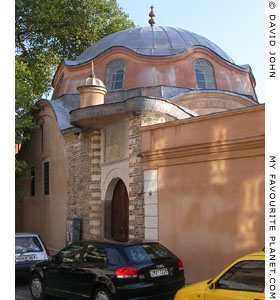
One the entrances of the Imaret,
on Odos Theodorou Poulidou. |
| |
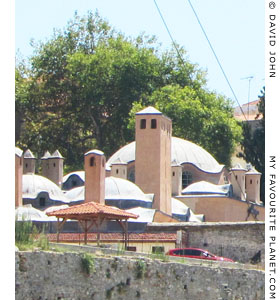
The chimneys and domes of the Imaret,
as seen from Kavala's main harbour. |
| |
| |
Halil Bey Mosque
Χαλίλ Μπέη Τζαμί, Halil Bey Jami; Turkish, Halil Bey Camii. Also referred to as το τζαμί του Χουσεΐν Μπέη, Houssein Bey Mosque.
The mosque complex is near the Imaret, up Odos Anthemiou, a narrow lane on the way up to the Kastro.
Although the extant mosque was built in the early 20th century, it stands on the grounds of an earlier mosque complex of the 16th century, which included a medressa (Islamic school), built on the foundations of an early Christian basilica. According to local tradition, this church was dedicated to Agia Paraskevi (Αγία Παρασκευή), an early Christian saint and martyr still popular in the Greek Orthodox Church today.
From 1930 to 1940 the mosque was the home of the Municipality Philharmonic Orchestra and was nicknamed the "Music Mosque" (Τζαμί της Μουσικής, Jami tis Mousikis) and the "Old Music" (Παλιά Μουσική, Palia Mousiki).
It was derelict for many years, was restored in 2008 and is now used for concerts and cultural events. The base of the original 16th century minaret can still be seen on the west side of the mosque, and archaeologists have also left the remains of the foundations of the previous buildings.
Odos Anthemiou 1, Kavala 65201.
Tel: 6932 378153 |
|
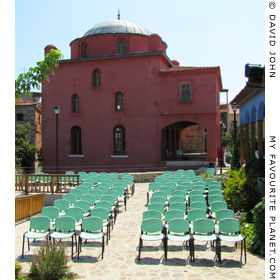
The courtyard of the Halil Bey Mosque,
with chairs set out for an evening
cultural event. |
| |
Mehmet Ali House
Σπίτι Μεχμέτ Αλί, Spiti Mehmet Ali; also known as the "Konaki" (κονάκι), after konak, Turkish for a house or official residence.
At the southern end of Odos Theodorou Poulidou is Plateia Mehmet Ali, a large paved square, designed by Ernesto Verucci Bey, the head architect at the Egyptian royal court. It was constructed in 1931-1934, after the widening of Odos Theodorou Poulidou, then called Odos Zalongou (Ζαλόγγου).
The square is lined on its western side by a row of houses, to the south is the large Greek Orthodox Panagia Church (see below), and at the northwest corner is the House of Mehmet Ali (also known as Mohammed Ali, 1769-1849), Pasha of Egypt and native of Kavala.
Built around 1780-90, the two-storey house is set in its own gardens, and had separate apartments for men (selamlik) and women (harem). At the time it was built it was the largest house in Kavala, and the only home with running water.
The ornate tomb of Zeyneb Hanim, Mehmet Ali's mother, which was originally in the area now occupied by Plateia Eleftherias (in the modern city centre), has been restored and now stands in the garden of the house.
Although the house was renovated over many years, and allegedly opened as a museum, every time I went to visit it, it was mysteriously closed. There was no information about opening hours, and no sign to indicate that it was a museum open to the public. Since my last visit to Kavala I have heard that it has been converted into a restaurant.
The house remains the property of the Egyptian Government, and the Greek and Egyptian flags hang over the front gate.
Plateia Mehmet Ali, Odos Theodorou Poulidou, Kavala 65110.
The house is administered by the Institute Mohammed Ali for the Research of Eastern Tradition (IMARET), an NGO established in 2006.
Tel: +30 2510 62 05 15
website: www.imaret.gr
The commercial website of the high-priced hotel in the Imaret and the exclusive restaurant in the Mehmet Ali House is in broken English.
The statue of Mehmet Ali
The bronze equestrian statue of Mehmet Ali on the square was made in Paris by Konstantinos Dimitriadis (Κωνσταντίνος Δημητριάδης, 1881-1943). It was commissioned by the Greeks of Egypt as a gift to the city of Kavala, and unveiled by Prince Amr Ibrahim of Egypt on 6 December 1949. |
|
|
| |
Kimisi Theotokou Church
The largest church in the Panagia district is known as the Ekklisia Kimisi Theotokou (Ιερός Ναός Κοιμήσεως της Θεοτόκου). Roughly translated, "Kimisis Tis Theotokou" means "falling-asleep" (or Dormition) "of the mother of God", the death of the Virgin Mary (in Greek Παναγία, Panagia, "all holy"); known to Roman Catholics as the Assumption of the Virgin Mary.
In the Greek Orthodox Church this event is celebrated on 15th August and is one of Greece's most important public holidays, after Easter and to many here more popular than Christmas. The holy day is usually celebrated with large public parties, music and dancing, particularly in villages.
The present church, also known simply as εκκλησία της Παναγίας, the Church of Panagia, was built in 1965, after the demolition of a much older post-Byzantine church of the 15th century, which was in the form of a three-aisled basilica with a small dome and a tall belltower. This itself replaced a small early Christian church, also dedicated to Kimisi Theotokou, which was the property of the Pantokrator monastery of Mount Athos. It is thought that this earlier church was demolished by the Turks, or it may have been destroyed during one several sieges which Kavala endured.
The Panagia district and peninsula were named after the Virgin Mary and this church after Macedonia gained its independence from Turkey in 1912.
It may now seem criminal that the 15th century church was demolished to make way for this modern building, however, during the 1960s attitudes to history and preservation were quite different. At this time old buildings were being demolished all over Europe in the name of "progress" and "modernity". It seems certain that some people would have considered the old church unsuitable for the requirements of a modern parish, and those who wished to make a statement with a newer, grander place of worship and symbol of Christianity and the new independent Greece. It may also be the case that the old structure was unsound and too expensive to restore and maintain.
At the end of Poulidou, Kavala 65201,
opposite the House of Mehmet Ali. |
|
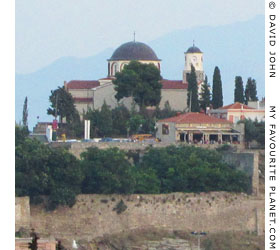
The Panagia Church from
the main harbour of Kavala. |
| |
The Lighthouse
Φάρος, Faros
The Panagia Headland ends just beyond the church, and there is a steep drop to the rocky coast. The small, whitewashed lighthouse at the very tip of the headland, originally constructed around 1880-1900, and rebuilt in 1929 and 1945, ceased operating in 1956. There was a lodge in which the lightkeeper lived, though this is no longer extant.
For many years the area around the Lighthouse was a popular meeting point where Kavalans danced on summer evenings.
The lighthouse is no longer directly accessible to the public because of the unsafe condition of the old defensive walls surrounding it, but the view from here across the Aegean Sea towards Thasos is quite beautiful.
At the end of Poulidou Theodorou, Kavala 65201. |
|
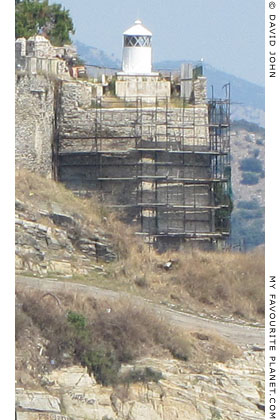
The Lighthouse (Faros) |
| |
Kavala Castle (Kastro)
At the top of Odos Hermionis, Kavala 65201.
Tel: +30 2510 83 86 02
Το κάστρο της Καβάλας, also known as the Frourio (Φρούριο, Fortress). It is also referred to as Kavala's "Acropolis" (high city), a name these days applied to the high parts of many ancient cities in Greece and Turkey.
The castle is highest point of the Panagia peninsula of Kavala, the oldest part of the city, which itself is surrounded by fortification walls. Destroyed, repaired and rebuilt numerous times since antiquity, much of the castle's present structure dates to around 1530, when Sultan Suleyman the Magnficent's Grand Vizier Pargali Ibrahim Pasha (see above) undertook several building projects in an attempt to revive the city which had been destroyed and depopulated by sieges of the previous century.
In the main courtyard there is a cafe, toilets and an open-air theatre for summer theatre, music and dance events. The ticket booth has some literature and souvenirs.
Opening times:
1 May - 30 September 08:00 - 21:00
1 October - 31 October 8:00 - 20:00
1 November - 31 March 8:00 - 16:00
1 April - 30 April 8:00 - 20:00
Admission: adults €2.50, children €1.50
website: www.castle-kavala.gr (in Greek and English) |
|
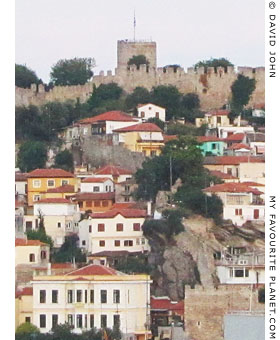
Kavala's Kastro above the old houses
of the Panagia district. |
|
| |
Kavala
sights |
Kavala museums |
|
 |
|
|
| |
Kavala Archaeological Museum
Αρχαιολογικό Μουσείο Καβάλας
Odos Erithrou Staurou 17, Kavala 65110.
About 600 metres west of the Town Hall and main harbour. Next to Faliro Park.
Tel: +30 2510 22 23 35
The fine, small archaeological museum has several interesting finds from the area around Kavala, as well as from other ancient settlements such as Amphipolis (see below) and Abdera (Ἄβδηρα), from the Neolithic period, to the Bronze Age and Classical, Hellenistic, Roman and early Christian eras.
Kavala's first archaeological collection was organized in 1934 by the archaeologist Georgios Bakalakis (Γεώργιος Μπακαλάκης, 1908-1991), the first Curator of Antiquities in Kavala (later Professor of Classical Archaeology at the Aristotle University of Thessaloniki). The museum was looted during the Bulgarian and German occupation of World War II, and many artifacts were smuggled abroad or destroyed.
The present museum, designed by Thessaloniki architects D. Fatouros and G. Triantaphyllides, was opened 1964, and a further wing was added in 2000. Since 2009 it has featured a permanent exhibition of the history of Kavala. The title "Neapolis-Christoupolis-Kavala" reflects the city's three historical names.
The main exhibition areas are on the ground floor of the spacious two-storey building. There are several fine, small, historically important objects, including statues, reliefs, inscriptions, pottery, gold and jewellery. Some of the painted pottery is especially fascinating.
The courtyard (atrium) and the garden behind the the building contain several statue bases, columns, capitals, funeral steles and an intact tomb monument in the form of a naiskos (ναΐσκος, small temple). There are also several Roman milestones from the ancient Via Egnatia (see below). Unfortunately, as at many museums, these outside sculptural works - some, such as the milestones, quite significant artefacts - are not labelled.
There is a museum shop to the right of the entrance selling postcards, books about local history and archaeology (some in Greek, English and German versions) and copies and casts of antiquities.
An illustrated leaflet about the museum is available free at the ticket desk, and a weighty catalogue of some of the museum's sculptures in Greek is on sale in the shop, but as yet no books about the collection have been published.
The first floor has an area for temporary exhibitions, a small lecture hall, and a space for educational programmes.
Opening hours:
Summer, Tuesday - Sunday 9:00 - 16:00
Winter, Tuesday - Sunday 8:00 - 15:00
Good Friday 12:00 - 15:00
Holy Saturday 08:00 - 15:00
Closed Mondays (like most museums in Greece)
and on the following holidays:
1 January
25 March (Independence Day)
Easter Sunday
25 December
Tickets:
€2, reduced (senior citizens) €1
Free admission for students and school children
Website:
odysseus.culture.gr/h/1/eh151.jsp?obj_id=3437
(in Greek and English)
The Odysseus website of the Greek Ministry of Culture and Sports provides very basic information about the country's archaeological sites and museums, with opening times, ticket prices, eligibility for reductions, free admission days and holiday closing. However, sometimes details are out of date, and much of the information in Greek is not available in English. Often exact addresses are not provided, and there are no directions for getting to sites or museums. |
|
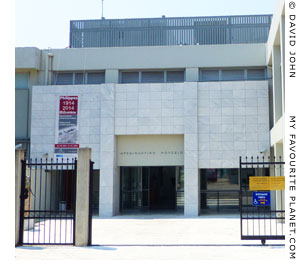
The entrance to
Kavala Archaeological Museum. |
| |
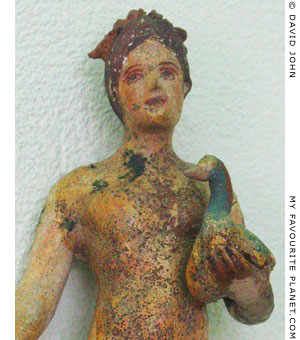
Detail of a painted ceramic figurine from
the 4th tomb of the Tumulus of Nikisianis,
Mount Pangaion. Circa 330-320 BC.
Kavala Archaeological Museum. |
| |
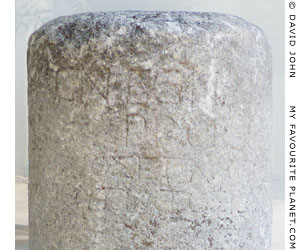
The top of a milestone found in 1974
in the Amygdaleon area of Kavala,
on the Via Egnatia (see below) between
Neapolis and Philippi, with a bilingual
inscription in Latin and Greek mentioning
Gnaius Egnatius, the Roman governor
of Macedonia responsible for the
construction of the road:
Cn[aeus] Egnati[us] G[aii] f[ilius]
proco[n]s[ul]
Γναῖος Ἐγνάτιος Γαΐου
ἀνθύπατος Ῥωμαίων.
(Cnaeus Egnatius, son of Gaius,
proconsul of the Romans)
On the the other side the Latin numeral
VII indicates a distance of 7 Roman miles
from Philippi.
Inscription SEG 40 543.
Kavala Archaeological Museum. |
|
| |
Tobacco Museum of Kavala
Το Μουσείο Καπνού Δήμου Καβάλας
This museum is a labour of love, created and maintained by one man, Yannis Byzikas (Γιάννης Βυζίκας), with little official help and a lot of political opposition. The small, atmospheric museum tells the story of tobacco cultivation, processing and trade in the Kavala area in objects, images and documents, with a strong emphasis on working methods and processes and the lives and conditions of the farmers and factory workers who produced the tobacco which made the owners and traders - the "tobacco barons" - rich men during the height of international demand for Macedonian and Balkan tobacco in the 19th and 20th centuries.
The genial Mr Byzikas gives personal tours of his museum, and is a wellspring of information about local history and culture. He is also the author of the book Χρονικό των εργατικών αγώνων (Chronicle of workers' struggles, Municipal Museum of Kavala, 1999), which tells the story of the struggle for workers' rights in Kavala from the beginning of the 20th century until the Second World War.
The museum was renovated in early summer 2018 and the exhibition has been reorganized.
Odos Konstantinou Paleologou 4, Kavala 65403.
Just north of (behind) the Town Hall.
Take Odos Eth. Makariou, just to the left of the Town Hall.
Odos Paleologon is first left, and the museum is on the right hand side after about 50 metres.
Tel: 2510 22 33 44
e-mail: info@tobaccomuseum.gr
website: www.tobaccomuseum.gr (in Greek only)
Opening hours:
Summer (June - September)
Monday - Friday 8:00 - 16:00
Saturday - Sunday 10:00 - 14:00
Thursday 17:00 - 21:00
Winter (October - May)
Monday - Friday 8:00 - 16:00
Saturday 10:00 - 14:00 Tickets: €2, reduced €1 |
|
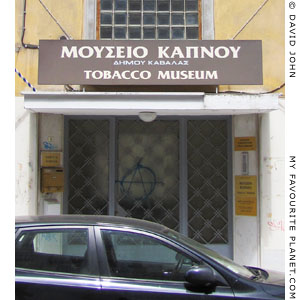
Entrance of the Tobacco Museum, Kavala |
| |
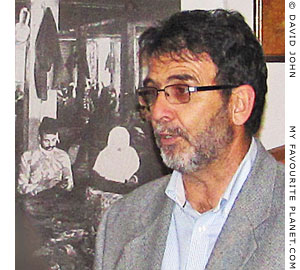
Yannis Byzikas, founder and director
of the Kavala Tobacco Museum. |
| |
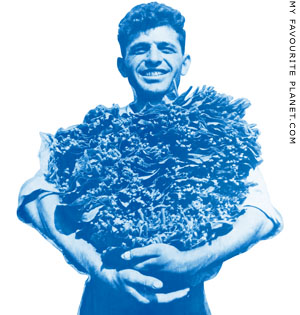
Vintage Macedonian tobacco harvest. |
|
| |
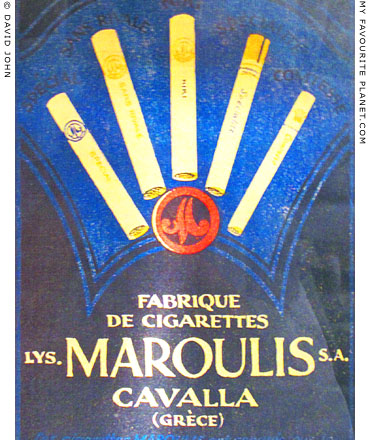
A poster for the Maroulis S.A. cigarette factory in Kavala.
The company produced and exported cigarette brands
named Special, Sans Rivale, Niki, Specialité and Comtesse.
Tobacco Museum of Kavala. |
| |
Municipal Folklore Museum
of Kavala
Το Δημοτικό Μουσείο Καβάλας
Currently closed (September 2018)
The collection of the Municipal Folklore Museum, established in 1969, has been moved to the Municipal Tobacco Warehouse on Kapnergatis Square, but has not been publicly exhibited for some years.
Museum departments: Historical Archives, Ethnographic Collection, Art Collection, Natural History, Library, Museum education
ILAK, the Historical and Literary Archives of Kavala (ΙΛΑΚ, Ιστορικό και Λογοτεχνικό Αρχείο Καβάλας) continues to operate.The archive is not open to the public, and due to budget and staff limitations is currently unable to respond to requests for information by researchers.
Website: www.ilak.org (in Greek only)
ILAK books and other publications in Greek are available from their bookshop in the city centre:
V. Grigoriadis, Art & Color
Odos Anexartisias 30, Kavala 65403.
Tel: +30 2510 22 89 20
They plan to offer publications for sale online from September 2018. |
|
|
| |
Maritime Museum of Kavala
Ναυτικό Μουσείο Καβάλας
Established in 2005, the Maritime Museum is now housed in the Municipal Tobacco Warehouse. It collects and exhibits a wide variety objects and documents related to sailing and seafaring, including tools used by sailors and shipbuilders, instruments and equipment from ancient anchors through sextants to modern radar devices, as well as folk paintings, photographs, ships' logs, books by seamen, models... in short all things nautical.
Kavala Municipal Tobacco Warehouse
Kapnergati Square, Kavala 65302.
Tel: +30 2510 233101
Website: www.nmkav.gr (Greek only)
Opening hours
There is no information about the museum's opening hours at the Municipal Tobacco Warehouse, on the museum's website or in the printed leaflet. However, according to the municipal website (which may not be up-to-date), the opening hours are:
Monday and Saturday 10:00 - 12:00
Tuesday, Thursday and Friday 19:00 - 21:00
Group and school visits by appointment.
Tel: 6977 391605
Entrance free |
|
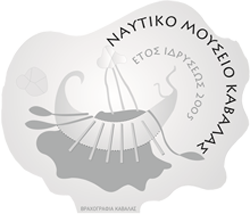
Maritime Museum of Kavala |
|
| |
Kavala
sights |
Sights near Kavala |
|
 |
|
|
| |
|
| |
The countryside, hills, mountains, rivers, coast, towns and villages around Kavala are well worth exploring for their natural beauty and diversity, historical importance and cultural wealth.
There is also a wide variety of beaches around the coast, some popular and others quite free of people. For the moment you will have to discover them for yourself, as we haven't got around to reviewing beaches yet.
Below are just a couple of the many attractions near Kavala. |
|
|
| |
|
|
|
|
Sights near
Kavala |
Agios Silas Monastery and the Via Egnatia |
|
 |
|
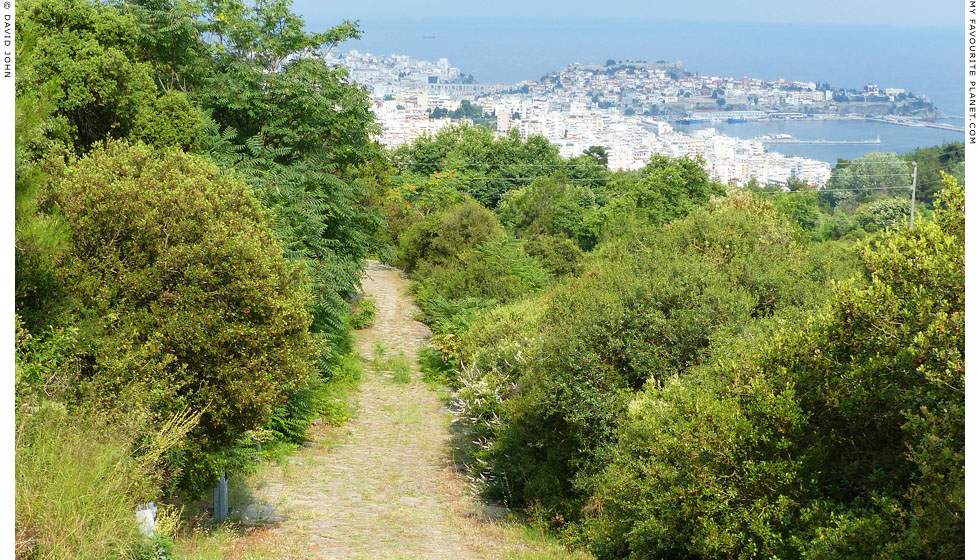
Part of the section of the ancient Roman Via Egnatia above Kavala.
The city centre, Kastro and the Kamares aqueduct are visible in the background. |
| |
| |
|
| |
Among the wooded hills above Kavala, about 2.5 km northwest of the city centre, are the Agios Silas Monastery and a short section of the ancient Via Egnatia.
The Monastery of Agios Silas
Ιερά Μονή Αγίου Αποστόλου Σίλα
The small monastery is dedicated to the Apostle Silas who accompanied Saint Paul on his journey to Neapolis and Philippi. A small church dedicated to Silas was built here in 1937, at the location where, according to Christian tradition, Paul and his companions Silas, Timothy and Luke rested on their way to Philippi.
The church was looted during the German and Bulgarian occupation of World War II. The Metropolitan Chrysostomos founded the monastery in 1946.
The monastery was set among the pine woods on the hills northwest of the city, overlooking the bay, and close to the ancient Via Egnatia (see below), the road along which Saint Paul and his companions walked to Philippi. This relatively peaceful and secluded setting has been disturbed in recent years by the expansion of the city up the hill, the building of the new hospital and hotels and the construction of a spaghetti junction of roads leading to and from the new E90 "Egnatia Odos" motorway and EO12 highway (see How to get to Kavala).
There is no information about opening times but, as at other Greek churches, the monastery is usually open daily until midday and during services.
The two most important religious celebrations at the monastery are the days of remembrance for the Apostle Silas on 30th July and for Holy Hieromartyr Anthimos on 3rd September.
A forest of road signs line the confusion of roads now surrounding the monastery, but none point the way to either the monastery or the Roman road. To get there, take the frequent number 11 bus from the city centre which stops close to the monastery entrance (tickets €1.50), or a taxi (around €5).
For further information see:
im-philippon.gr/IeroiNaoi/ApostolosSilas.html
The Via Egnatia
Αρχαία Εγνατία Οδός, Ancient Egnatia Odos
The ancient Roman road which ran across the Balkans from the Illyrian port of Dyrrachium (the Corinthian colony Ἐπίδαμνος, Epidamnos; today Durrës, Albania), across the Roman provinces of Macedonia and Thrace in northern Greece, and terminating at Byzantium (later Constantinople, today Istanbul).
Construction of the first highway across the Balkans was begun during the late 140s BC, and named after Gnaeus Egnatius, proconsul, governor of Macedonia. It ran through several cities in northern Greece, and Neapolis (the ancient name for Kavala) was an important station along its route.
Although scholars still debate the exact route (or routes as the road had a number of secondary courses and connected roads) of the Via Egnatia, since 1949 the discovery of several bilingual milestones (miliaria) in Roman and Greek, some mentioning Gnaeus Egnatius, have confirmed many of the major points along its course, including Thessaloniki, Amphipolis, Philippi (see below) and Neapolis (Kavala). See a photos of milestone in Kavala Archaeological Museum above and below right, and another in Thessaloniki Archaeological Museum on History of Stageira and Olympiada part 7.
There is also a short section of the Via Egnatia to be seen at Philippi, as well as other stretches between Kavala and Philppi. During his mission to Macedonia the Apostle Paul travelled along this road from Neapolis to Philippi, and then on to Thessaloniki and Veria.
Some years ago there was an ambitious renovation project to attract tourists and hikers to the 2 km stretch of the Via Egnatia at Kavala, and lighting and picnic areas with water fountains were set up along the ancient road. However, there appears to have been almost no investment made in informing people about the route, or even signposting it. This remains true today, and local maps do not highlight the road, nor does the otherwise excellent Kavala Tourist Information Centre (see page 3) have any information about it.
Even the Kavala Archaeological Museum makes little effort to draw attention to the Via Egnatia, and the important Roman milestones stand outside in the courtyard with no labelling or information.
Consequently, the road has been badly neglected in recent years, has been built over in places, and was split into two sections during the construction of the Odos Egnatia motorway and its approach roads. The lights have been dismantled and the water fountains no longer work.
The only visitors appear to be occasional organized groups of Christian religious tourists and a few intrepid independent travellers. The neglect and the use of the road by "adventure" cyclists and enduro motorbikers, as well as agricultural vehicles, have damaged and loosened some of the ancient paving stones between which weeds are now growing. In many places the path is in danger of becoming overgrown or disintegrating altogether.
The surviving section of the Via Egnatia to the west of the motorway, towards the settlement of Stavros, is now difficult to get to or even find without private transport and a good map. It appears that it has now been abandoned and left to be destroyed by man and nature.
Nevertheless, the stretch of the road east of the motorway, between the Agios Silas Monastery and the outskirts of Kavala is still worth visiting, and is a pleasant downhill stroll among pine trees, flowers, blackberry bushes and fields. The road itself is fascinating, and there are excellent views over the city and the Aegean Sea to the island of Thasos. The walk takes around an hour, depending on your walking speed.
To get to the top of this section of the ancient road, take the National Road EO12, also signposted as 7is Merarchias Street, turning into Odos Iokastis (Οδός Ιοκάστης), uphill out of the city centre. After a 1.5 km there is a new roundabout, just beyond which is the large new Kavala General Hospital (straight ahead), and to the right a modern semi-circular building (currently under construction, see photo right) in front of the monastery.
The frequent local bus Number 11 from the city centre stops near the roundabout from where you can visit the monastery and the Via Egnatia. The bus fare is €1.50, and tickets can be bought from kiosks in the centre, or from the bus driver (see How to get to Kavala for further details about local buses). A taxi from the centre costs about €5.
On the right side of the road, just before the roundabout, a modern paved footpath leads to the start of the section of the Via Egnatia. To the left is the high concrete wall of the embankent of the road continuing out of town. The ancient road starts after about 100 metres, and suddenly the surroundings become much greener and quieter.
The road from here down to the town is easy to follow, although at some places the gradient is steep as 20 per cent and the paving stones can get slippery when it rains. Watch out for loose paving stones underfoot.
The only refreshments on sale in the area is a kantina van (Kantina Hallara, 9 am – 10:30 pm) at the entrance to the hospital car park. So take plenty of water and whatever you may need to eat along the way.
The road itself is around 3 metres wide and paved with irregularly-shaped stones of various sizes, with large slabs at either edge (see photo below). It has been repaired and rebuilt several times over the centuries and remained an important route through the Byzantine and Ottoman Empires until it was replaced by modern roads in the 20th century.
After less than 1 km the road is crossed by a modern street serving a few houses, and there are also a few paths and tracks used by farmers along the way.
At the end of the stretch of ancient road houses begin to appear and then you are suddenly back on modern streets of the Byronas district in northwestern outskirts of Kavala, below the large Hotel Egnatia. From here the modern streets Odos Egnatias and Odos Macedonias meet, and this is also where the frequent Number 1 bus terminates and stops for 5-10 minutes before returning to the city centre. You can either take the bus (€1.50) or walk along Odos Egnatias which zig-zags down to the centre (1.5 km).
The modern Odos Egnatias roughly follows the ancient route to the centre of Kavala which used to lead to the Kamares aqueduct and then on towards Xanthi. Walking through the suburbs is quite pleasant, and there are houses in a variety of 20th century architectural styles along the way. Odos Egnatia ends at the busy coastal road Chrisostomou Smirnis (part of National Road EO2) just west of Kavala's main port. |
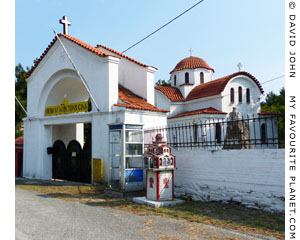
The entrance to the
Monastery of Agios Silas. |
| |
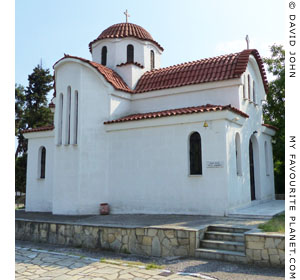
The church of Agios Anthimos
(Αγιος Ανθιμος) in the grounds
of the Monastery of Agios Silas. |
| |
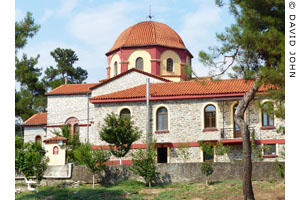
The main church of Apostle Silas
at the Monastery of Agios Silas. |
| |
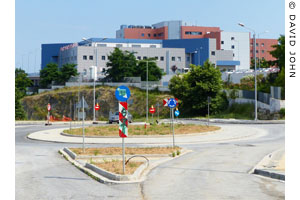
The roundabout before the hospital,
near the start of the Kavala stretch
of the ancient Via Egnatia. |
| |
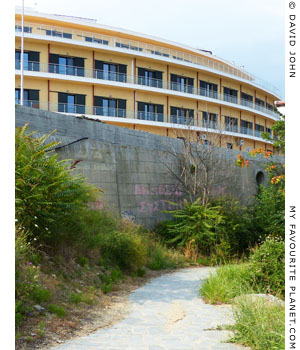
The footpath leading to the start
of the ancient Via Egnatia,
just before the roundabout. |
| |
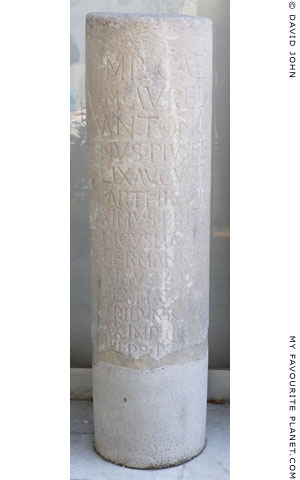
A Roman milestone of the Via Egnatia,
set up during the reign of
Emperor Marcus Aurelius Antoninus
(121-180 AD, Emperor 161-180 AD).
Kavala Archaeological Museum. |
| |
| |
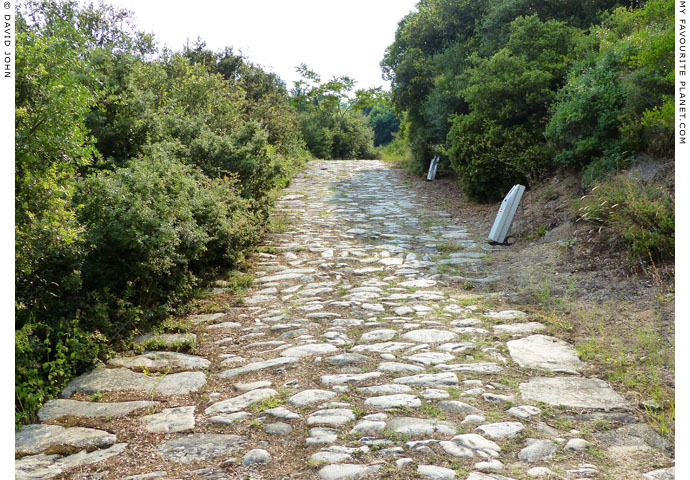
The stony ancient Via Egnatia at Kavala (view westward up the road in the direction
of the Agios Silas Monastery). Note the larger stones at the sides of road, and the
broken lamps on the right. The lamps not only allowed people to take evening walks
along the ancient way, but also made the illuminated road visible from the city below. |
| |
Sights near
Kavala |
Philippi |
|
 |
|
The Archaeological Site and Museum of Philippi (Φίλιπποι), 17 km north of Kavala.
The ancient Thassian colony of Krinides (Κρηνἱδες, Fountains) was renamed after Philip II of Macedon (father of Alexander the Great) who conquered it in 356 BC.
The strategically important city lay on the broad plain between Mount Pangaion and Mount Lekani which was an important route between the Aegean and the Thracian hinterland. It also controlled the rich gold and silver mines of the area.
It became famous as the site of the decisive Battle of Philippi between the armies of the Roman republicans Brutus and Cassius and Julius Caesar's successors Mark Antony and Octavian (later to become Emperor Augustus) in 42 BC. The latter won and the republic was history.
The Apostle Paul visited Philippi around 49 AD, having travelled from Troy via Samothraki and Neapolis (Kavala), and established the first church in Europe here. (see page 2: History of Kavala) Christian churches were later built over ancient pagan sanctuaries.
In Roman times Philippi had a substantial Jewish community. As at other places on Paul's missionary journeys (such as Thessaloniki and Veria), it was the Jews who were the primary target for his conversion programme.
Thus the site attracts not only those interested in Greek and Roman history but also a great number of Jewish and religious Christian tourists.
The site is quite large, with ruins from several historical periods, mostly Roman and early Christian. Most visitors do not make it up to the city's acropolis, which is quite a climb up a rough track; there is not much to see except the excellent views of the plain the mountains and distant Drama. The new archaeology museum is definitely worth visiting for some fine exhibits and historical contexts.
Buses between Kavala and Drama, every 30 minutes, stop at the village of Krinides, 1 km from Philippi archaeological site and museum. See page 5: How to get to Kavala - Drama and Philippi.
Philippi Archaeological Museum and site
Tel: +30 2510 516251
Opening hours:
Summer
Tuesday - Sunday 08:00 - 20:00
Monday 13:00 - 19:30
Winter
Tuesday - Sunday 08:00 - 15:00
Monday closed
Good Friday 12:00 - 17:00
Holy Saturday 08:00 - 15:00
Closed on the following holidays:
1 January
25 March (Independence Day)
Easter Sunday
1 May
25 December
Tickets: €6, reduced €3
Website:
odysseus.culture.gr/h/1/eh155.jsp?obj_id=3376
(see above for caveats about the Odysseus website) |
|
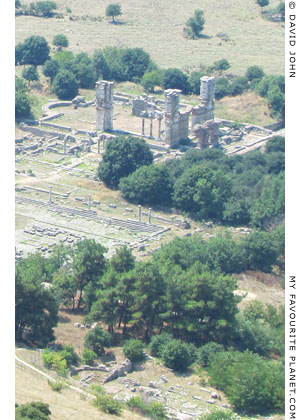
Part of the archaeological site of Philippi
from the acropolis. |
|
| |
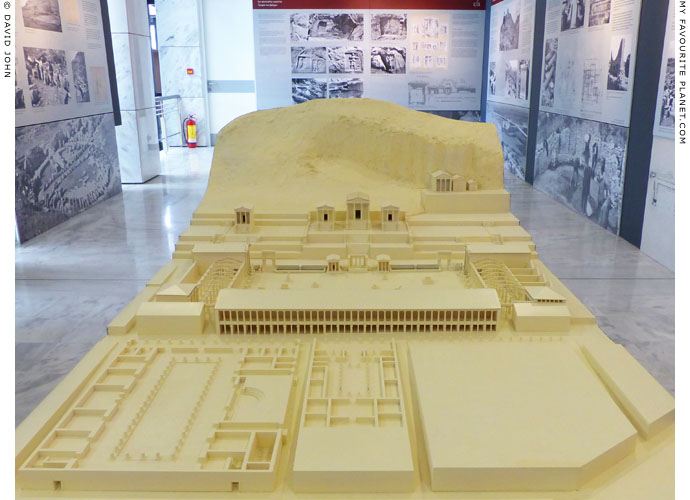
A model of the Roman forum and commercial agora of Philippi in Kavala Archaeological Museum.
Conception by M. Sève and P. Weber; constructed by P. Christmann, 1996.
Exhibited during the temporary exhibition about the history of archaeological excavations
at Philippi by the French Archaeological School in Athens (l'École française d'Athènes), 2015.
|
| The exhibition included large information boards in French and Greek, with photos of the archaeologists, work on the sites and the life of local people, as well as drawings and plans of excavated buildings. There was also a documentary video, a scale model of the Agora of Philippi and a display of archaeologists' journals, including sketches, which visitors could leaf through. |
|
|
| |
Sights near
Kavala |
Thasos island |
|
 |
|
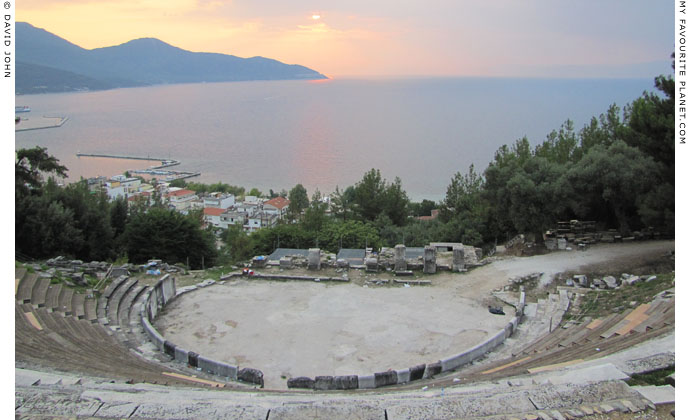
The ancient theatre of Thasos, overlooking the harbour of Thasos town. |
| |
Thasos (Θασος) is one of the most attractive of the Northern Aegean islands and justifiably renowned for being very green, mainly because of its pine trees. The words "emerald" and "isle" are often use to sell the island to tourists. It has rich vegetation, a good, hospitable atmosphere, a lively main town, pretty villages, good beaches and fascinating archaeological museum and sites.
It is really a pleasure to sit in the ancient ampitheatre, high above the main town of Thasos (also known as Limenas, Λιμένας Θάσου, Limenas Thasou, Harbour of Thasos), on a summer evening and be entertained by the theatre and musical performances presented there. Above, the stars, below, the lights of the harbour and passing boats. The plays are usually in Greek, but even if you do not understand the language, the shows are visually spectacular.
A relatively small island, it is possible to drive right around it in a day, should you really want to.
Thasos does not have an airport, but is easy to get to by ferry from Kavala and Keramoti, the port near Kavala Airport. See page 4: How to get to Kavala - Ferries to Thasos.
Thasos bus information: +30 2593 02 21 62
The ancient theatre of Thasos is currently closed for restoration work. It was due to reopen for Summer 2018, but so far there has been no announcement that this has happened. Ask at the museum or your hotel before climbing up the hill.
Thasos Archaeological Museum
Odos Megas Alexandrou 2, Limenas Thasos 64004.
The museum and the archaeological site of the agora are on the eastern edge of Thasos town, near the old harbour (Παλιό Λιμάνι), at the junction of Megas Alexandrou Street and 18th October Street.
Tel: +30 25930 22 180
Opening hours:
Summer
Tuesday - Sunday 08:00 - 20:00
Monday closed
Winter
Tuesday - Sunday 8:00 - 15:00
Monday closed
Good Friday 12:00 - 17:00
Holy Saturday 8:00 - 15:00
Closed on the following holidays:
1 January
25 March (Independence Day)
Easter Sunday
1 May
25 December
In summer the archaeological site is open 08:00 - 18:30.
Tickets: €2, reduced €1
Some other archaeological areas around the town are fenced off and normally not open to the public, but can be seen through or over the fences. The large area of the acropolis above the town is unfenced, free and always open, although the footpaths in some places are overgrown and and not easy to walk around.
Website:
odysseus.culture.gr/h/1/eh155.jsp?obj_id=3331
(see above for caveats about the Odysseus website) |
|
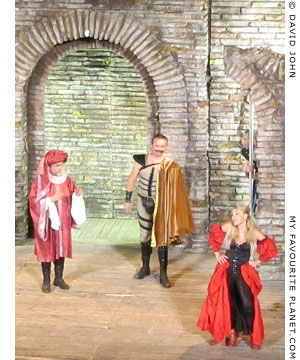
A spirited, hilarious, action-packed
production of William Shakespeare's
comedy The taming of the shrew
in the ancient theatre of Thasos
(July 2010). The arch and walls
are modern stage scenery. |
|
| |
Sights near
Kavala |
Ethnological Museum, Nea Karvali |
|
 |
|
The Historical and Ethnological Museum of the Greeks of Cappadocia and the Centre for Cappadocian Studies (Ιστορικό και Εθνολογικό Μουσείο Νέας Καρβάλης), founded in 1995.
The museum focuses on the history and lives of the Greek people who lived for millenia in the Cappadocia region of Turkey. Following the forced population exchange between Greece and Turkey in 1923 many of the Greek refugees from Cappadocia settled in and around Kavala.
The village of Nea Karvali, 11 km east of Kavala, was named by Greek refugees from Karvali in Cappadocia, today known as Gelveri.
Nea Karvali, Kavala 64006.
Tel: +30 2510 31 61 92, +30 2510 31 66 48
e-mail: info@stegi-karvalis.gr
Opening hours: Monday - Friday 08:30 - 13:00
Entrance fee: 3 €; groups 2 €; schools 1 € |
|
|
|
| |
Sights near
Kavala |
Olive and Oil Museum, Elaiochori |
|
 |
|
|
Olive and Oil Museum (Μουσείο Ελιάς, Mouseio Elias), was established in 1970 in an old abandoned oil mill in the village of Elaiochori (Ελαιοχώρι), 25 km southeast of Kavala, along the coast road (EO2 National Road), on the south slope of Mount Symvolo.
Elaiochori, 64100 Kavala.
Tel: +30 2594 09 23 41
Fax: +30 2594 09 23 41
website:
imma.edu.gr/macher/museums/
show.html?museum_id=20
Opening times: Tuesday - Friday 8.00 - 14.00
Entrance FREE, donations appreciated. |
|
|
|
| |
Sights near
Kavala |
Wax Museum, Eleftheroupoli |
|
 |
|
Madame Tussauds, Greek style. Created by Berlin-born Kavalan Theodoros Kokkinidis (θεόδωρος Κοκκινίδης), the waxen VIPs on display include Michael Jackson, Madonna, Johnny Depp, Angelina Jolie, Princess Diana, Maria Callas, Melina Merkouri and Andreas Papandreou.
Whether you are a fan of waxworks or not, if you are travelling around Macedonia you may find it interesting to visit the farming and market town of Eleftheroupoli (Ελευθερούπολη, Freedom City) at the foot of Mount Pangaion. Like Kavala it also had a tobacco boom, and the old tobacco warehouses can still be seen. It is also a good base for trekking up Mount Pangaion.
Το νεοσύστατο μουσείο κέρινων ομοιωμάτων,
Kipia, Eleftheroupoli, 64100 Kavala.
Tel: +30 6937 80 37 80
website: www.kerinaomoiomata.gr (Greek only)
17 km (around 25 minutes) west of Kavala city centre.
Take the National Road EO12 northwards, out of Kavala towards Philippi and Drama, then turn left onto a minor road, signposted for Eleftheroupoli.
There are 7-8 buses per day to Eleftheroupoli, along the route between Thessaloniki and Kavala.
Opening hours:
Winter (October – May):
Monday - Sunday 10:00 – 18:00
Summer (June - September):
Monday - Sunday 10:00 – 20:00
Entrance fee: 5 €, high school pupils 4 €,
primary school pupils and college students 3 €. |
|
|
|
| |
Sights near
Kavala |
Amphipolis |
|
 |
|
62 km northwest of Kavala, on the other side of Mount Pangaion, are the remains of Amphipolis (Ἀμφίπολις), another historically important ancient city, once a colony of Athens, and the scene of many dramatic and influential events in ancient times.
Although the ruins of Amphipolis are meagre compared to those of Philippi, the location is dramatic and the views over the valley of the River Strymon and surrounding mountains are wonderful.
Archaeologists are currently busy excavating in and around the city, and fascinating new discoveries about its history are being made constantly.
The Amphipolis Archaeological Museum is excellent, both in terms of design and the quality of its exhibits.
The farming village of Amphipoli (Αμφίπολη) is tiny, but the people are very friendly and hospitable.
There are also several Macedonian tombs in the area.
Amphipolis is less than hour's drive west of Kavala. We have not yet discovered a direct bus connection.
There are buses between Kavala and Serres, 60 km north of Amphipolis. Distance Kavala-Serres 62 km northwest; journey time around 45 minutes.
For further details of buses between Kavala and Serres, see page 4: How to get to Kavala.
Serres is an interesting town itself, with a large market hall, two museums, an ancient fortress, old churches and a venerable mosque. It also has a railway station with train connections to Thessaloniki to the west, and Drama, Xanthi, Komotini, Mesti and Alexandroupolis in the east.
From Serres you can take a Serres-Thessaloniki bus to Amphipolis. Around every 1.5 hours, journey time around 45-60 minutes.
The bus stop for Amphipolis is on the main road (to Drama), 500 metres east of the village and museum (uphill walk). From the museum, the main hilltop archaeological site (entrance free) is a 10 minute walk (more uphill).
The coastal route between Kavala and Amphipolis is also interesting and attractive. However, since the completion of the Egnatia motorway, very few buses travel between Kavala and Thessaloniki along the coast road (National Road EO2) via Asprovalta and Stavros (in winter only one a day!). Those that do will stop at or just outside the village of Nea Kerdilia (Νέα Κερδύλια), just west of the mouth of the River Strymon, 3 km south of Amphipolis (14 km east of Asprovalta).
On the other side of Nea Kerdilia village, just before the metal bridge over the Strymon, stands the famous Lion of Amphipolis monument.
From Nea Kerdilia you can walk or hitch along the National Road EO59, or catch a Thessaloniki-Serres bus (around every 1.5 hours).
Occasionally taxis stray along the road, and it is possible, though expensive, to phone a taxi from Nea Kerdillia. You may even be able to negotiate with a taxi driver to wait for you while you visit the museum and site. Allow at least 30-45 minutes for each.
There are no taxis at Amphipolis, but it is possible to phone for one. Ask for the phone number at the cafe opposite the museum entrance.
The Archaeological Museum and site of Amphipolis
Amphipolis, 65052 Serres (Prefecture of Serres)
Tel: +30 23220 32 474
Opening hours: Summer, 1st June - 31 October 2018, every day 8:00 - 20:00
Closed on official holidays.
Tickets: €6, reduced €3
Archaeological site of the acropolis: entrance free, usually open until sunset
Website:
odysseus.culture.gr/h/1/eh155.jsp?obj_id=3250
(see above for caveats about the Odysseus website)
NOTE: The recent changes to museum opening hours are a big improvement. It used to close at 3 pm! Other museums in Greece still do, particularly in winter. This is pretty early, especially for those who have travelled a long way to get here, only to find the museum closed.
Like many of the important museums in Greece, it is now open 7 days a week (even on Mondays!), at least in summer. As at all museums in Greece, the admission price has recently been incresed considerably.
The opening times for winter, November 2018 - May 2019, have not yet been published (September 2018).
The archaeological site actually stays open longer, and once you are in you can stay a while. Last time I was there the wasn't a guard or ticket office. In fact there was nobody else there at all.
Some archaeological areas around Amphipolis, such as the gymnasium and the Roman bridge (which are quite a distance from each other), are fenced off and can only be entered by arrangement with the museum. When they have sufficient staff, quick tours of these areas may be offered for groups. |
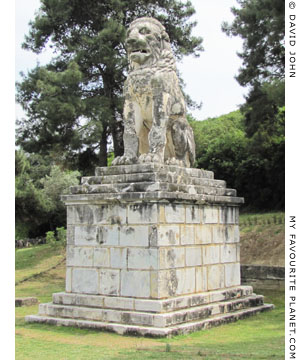
The Lion of Amphipolis
Near the River Strymon, on the road from
Nea Kerdillia to Amphipolis and Serres.
A late 4th century BC funerary monument
for Laomedon of Lesbos, one of Alexander
the Great's admirals and satrap of Syria
after the king's death. |
| |
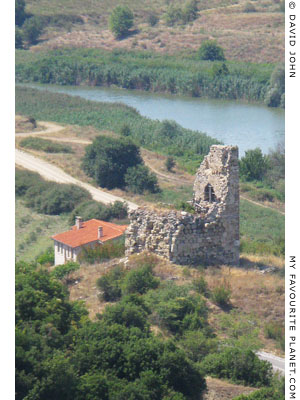
Medieval tower on the west side of
Amphipolis, overlooking the River
Strymon and the road between
Serres and the Aegean coast. |
| |
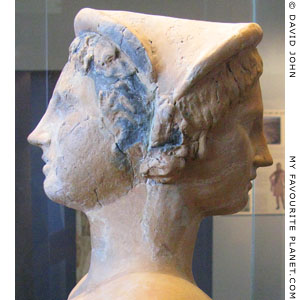
Ceramic double bust of the mysterious
god Attis, 2nd - 1st century BC,
in Amphipolis Archaeological Museum. |
| |
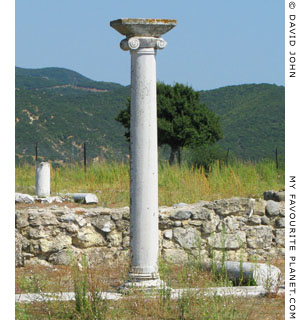
Remains of an early Christian basilica
on the acropolis of Amphipolis. |
| |
| |
Kavala
sights |
Notes, references and links |
 |
|
1. The Wix Collection of antiquities
A number of articles were published at the beginning of the 20th century about the collection of ancient sculptures, inscriptions and ceramics in the Wix Mansion in Kavala. See, for example two illustrated articles in German about antiquities acquired by Adolf Wix from Thasos and Amphipolis:
Jahreshefte des Österreichischen Archäologischen Institutes in Wien, Band 11. Heinrich Sitte, Thasische Antiken, pages 142-164, Tafel I-IV and Figs. 36-57; and Heinrich Sitte, Antiken aus Amphipolis, Beiblatt (supplement), columns 97-102 and figs. 65-69. Alfred Hölder, Vienna, 1908. At the Internet Archive.
The Archaic marble "Wix head" (photo, right) was purchased by Adolf Wix in 1906 from a private owner in Thasos, who had owned it since at least 1900. At the time it was believed to be from a kouros statue and was dubbed "Apollo-Kopf" ("Apollo head"), as many kouroi were thought to represent Apollo. After being taken to Vienna, where it was studied by scholars including Heinrich Sitte, it was sold in 1935 to the Ny Carlsberg Glyptotek, Copenhagen.
Part of the body of a marble sphinx statue excavated in the agora of Thasos in 1987 was found to match the head. A replica of the head was fitted to the body, and is now exhibited as the "Wix Sphinx" in Thasos Archaeological Museum (sphinx body Inv. No. 3807).
See:
Frederik Poulsen, Catalogue of ancient sculpture in the Ny Carlsberg Glyptotek, No. 18a, pages 37-39. Ny Carlsberg Foundation, Copenhagen, 1951. At Heidelberg University Digital Library.
Holtzmann Bernard, Une sphinge archaïque de Thasos. In: Bulletin de correspondance hellénique, Volume 115, livraison 1, 1991, pages 125-165. At Persée. |
|
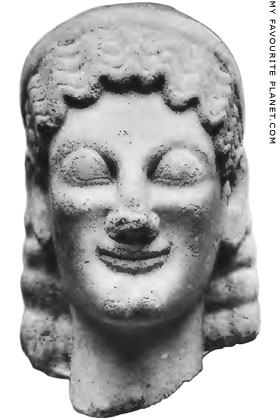
The "Wix head", the head of an
Archaic marble statue of a sphinx
from Thasos, formerly in the
Adolf Wix collection in Kavala.
570-560 BC. Thasian marble.
Height 27.5 cm, height of face 15 cm,
width 17 cm, depth 21 cm.
Ny Carlsberg Glyptotek, Copenhagen.
Inv. No. 2823.
Source: Heinrich Sitte, Thasische
Antiken, Tafel II (see note 1). |
|
Photos, maps and articles: copyright © David John,
except where otherwise specified.
Some of the information and photos in this guide to Kavala
originally appeared in 2004 on davidjohnberlin.de.
All photos and articles are copyright protected.
Images and materials by other authors
have been attributed where applicable.
Please do not use these photos or articles without permission.
If you are interested in using any of the photos for your website, project or publication, please get in contact.
Higher resolution versions are available on request.
My Favourite Planet makes great efforts to provide comprehensive and accurate information across this website. However, we can take no responsibility for inaccuracies or changes made by providers of services mentioned on these pages. |
|
| |
 |
Visit the My Favourite Planet Group on Facebook.
Join the group, write a message or comment,
post photos and videos, start a discussion... |
|
|
| |
|
|
| |
| |
 |
| |
George Alvanos
rooms in
Kavala's historic Panagia District
Anthemiou 35,
Kavala, Greece
kavalarooms.gr
|
| |
 |
| |
 |
| |
 |
| |
 |
| |
 |
| |
Olive Garden Restaurant
Kastellorizo,
Greece
+30 22460 49 109
kastellorizo.de
|
| |
Papoutsis
Travel Agency
Kastellorizo,
Greece
+30 22460 49 286
greeklodgings.gr
|
| |
| |
|